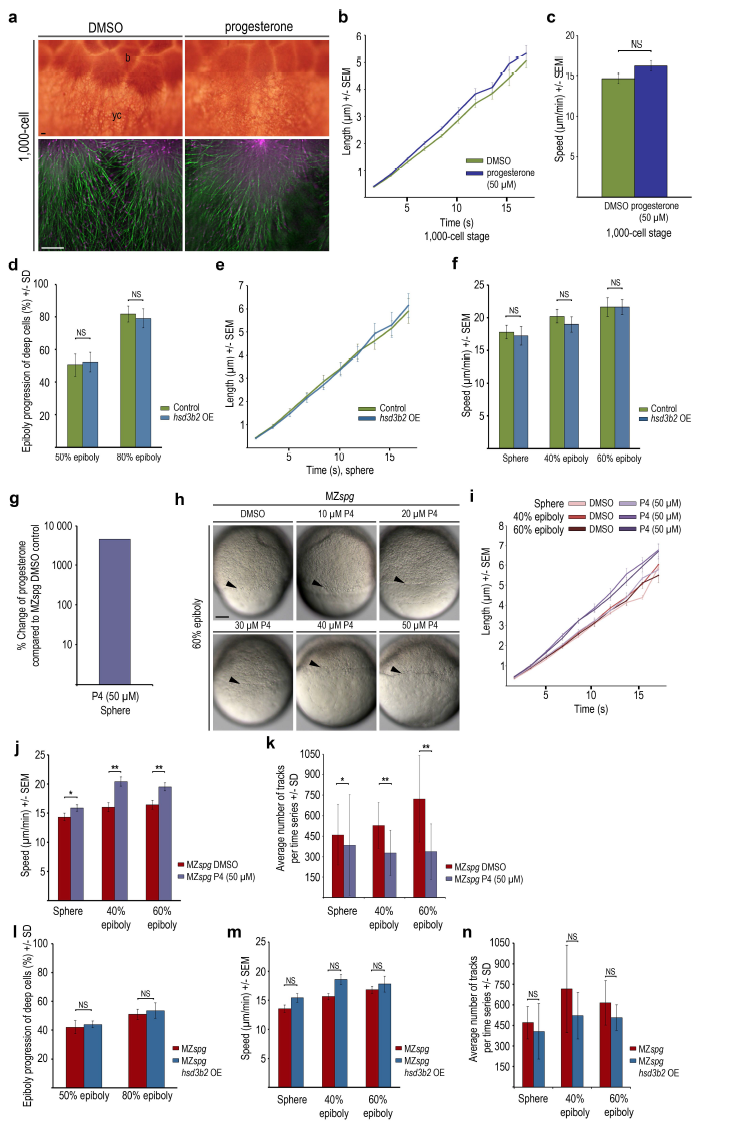Fig. S5
Yolk cell microtubule structure and dynamics in progesterone treated or hsd3b2 overexpressing embryos
(a) YCL region of DMSO or progesterone (50 ?M) treated wild-type embryos at 1000-cell stage (3 hpf). Upper row: Anti-ß-tubulin immunostaining show marginal blastomeres (= b) fusing with yolk cell (= yc). Lower row: Live TIRF images of EMTB-3GFP (green) and EB3-mCherry (magenta) labeled embryos. Lateral view, animal to the top, scale bar 10 ?m.
(b) Microtubule growth at 1000-cell plotted as EB3-mCherry track length (?m) over track duration (s) for DMSO control and progesterone (50 ?M) treated wild-type embryos. Error bars indicate SEM (DMSO n = 9; progesterone n = 11).
(c) Average speed of microtubule growth at 1000-cell stage for DMSO and progesterone (50 ?M) treated wild-type embryos. Error bars indicate SEM. Same dataset analyzed as in (b). Microtubule growth speed difference between DMSO and progesterone treated embryos was not significant (Mann- Whitney test).
(d) Quantification of epiboly progression of control or hsd3b2 mRNA injected wild-type embryos at indicated stages. Error bars indicate SD (control experimental series: 50% epiboly n = 16 embryos, 80% epiboly n = 10; hsd3b2 mRNA injection experimental series: 50% epiboly n = 18, 80% epiboly n = 12). Differences between control and hsd3b2 mRNA injected embryos were not significant (Mann- Whitney test). OE = overexpression.
(e) Speed of microtubule growth at sphere plotted as EB3-mCherry track length (?m) over track duration (s) for control and hsd3b2 mRNA injected wild-type embryos. Error bars indicate SEM (control n = 8; hsd3b2 mRNA n = 9). OE = overexpression.
(f) Average speed of microtubule growth tracks at indicated stages for control and hsd3b2 mRNA injected wild-type embryos. Error bars indicate SEM (controls: sphere n = 8, 40% epiboly n = 9, 60% epiboly n = 9; hsd3b2 mRNA injections: sphere n = 9; 40% epiboly n = 10; 60% epiboly n = 10). Statistical analysis revealed no significant differences between control and hsd3b2 mRNA injected embryos (Mann-Whitney test). OE = overexpression.
(g) Incubation of MZspg embryos in 50 ?M progesterone from 2 hpf onwards increases progesterone levels more than tenfold when extracts are prepared at sphere stage. Concentration of progesterone quantified by ELISA.
(h) Images of live MZspg embryos at 60% epiboly treated with indicated progesterone concentrations and DMSO control. Arrowheads mark blastoderm margin. Lateral view, animal to the top, scale bar 100 ?m.
(i) The speed of microtubule growth at indicated stages plotted as EB3-mCherry track length (?m) over track duration (s) for MZspg embryos in DMSO controls or upon or progesterone (50 ?M) treatment. Error bars indicate SEM (sphere: DMSO n = 17; progesterone n = 18, 40% epiboly: DMSO n = 17; progesterone n = 20, 60% epiboly: DMSO n = 15; progesterone n = 17).
(j) Average speed of microtubule growth at indicated stages for MZspg embryos in DMSO controls or upon progesterone treatment. Error bars indicate SEM. Same dataset analyzed as in (i). Progesterone induced an increase in average microtubule growth speed at sphere stage (15.9 ?m/min SEM 0.5 treated versus 14.3 ?m/min SEM 0.7 control). At 40% epiboly (20.4 ?m/min, SEM 0.8 treated versus 16.0 ?m/min, SEM 0.7 control) and 60% epiboly (19.5 ?m/min SEM 0.7 treated versus 16.4 ?m/min SEM 0.75, control) the increase was even stronger. Differences of microtubule growth speed between MZspg control and progesterone treated embryos were significant (p < 0.05 at sphere; p < 0.005 at 40% epiboly and 60% epiboly; Mann-Whitney test).
(k) The average number of EB3-mCherry tracks in a defined area at indicated stages of MZspg embryos treated with DMSO or progesterone. Error bars indicate SD. Same dataset analyzed as in (i). Difference in track number between control and progesterone treated embryos was significant (p < 0.05 at sphere; p < 0.005 at 40% epiboly and 60% epiboly; Mann-Whitney test).
(l) Quantification of epiboly progression at 50% and 80% epiboly of control or hsd3b2 mRNA injected MZspg embryos. Error bars indicate SD (50% epiboly: control n = 13, hsd3b2 mRNA n = 14; 80% epiboly: control n = 11, hsd3b2 mRNA n = 12). Data revealed no significant differences between control and hsd3b2 mRNA injected embryos. OE=overexpression (Mann-Whitney test).
(m) Average speed of microtubule growth at indicated stages of control or hsd3b2 mRNA injected MZspg embryos treatment. Error bars indicate SEM (sphere: control n = 7; hsd3b2 mRNA n = 8, 40% epiboly: control n = 9; hsd3b2 mRNA n = 8, 60% epiboly: control n = 8; hsd3b2 mRNA n = 10). Data revealed no significant differences between control and hsd3b2 mRNA injected embryos (Mann- Whitney test).
(n) Average number of EB3-mCherry tracks at indicated stages of control or hsd3b2 mRNA injected MZspg embryos. Error bars indicate SD. Same dataset analyzed as in (m) Data revealed no significant differences between control and hsd3b2 mRNA injected embryos (Mann-Whitney test).
Reprinted from Developmental Biology, 434(2), Eckerle, S., Ringler, M., Lecaudey, V., Nitschke, R., Driever, W., Progesterone modulates microtubule dynamics and epiboly progression during zebrafish gastrulation, 249-266, Copyright (2017) with permission from Elsevier. Full text @ Dev. Biol.

